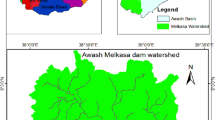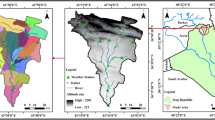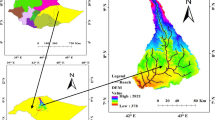Abstract
Soil loss is one of the most important concerns that experts are looking into for successful watershed management. The goal of this research is to use a modeling approach to estimate the spatial sediment yield and identify hotspot locations at the sub-watershed level within the Finca'aa watershed in the Abay River Basin, Ethiopia, from 1999 to 2017. The constructed rating curve from measured discharge—sediment loading was used to generate sediment data for the calibration and validation process. Model sensitivity analysis, calibration, and validation were performed using the Sequential Uncertainty Fitting version-2 (SUFI-2) technique. The calibration and validation are based on adjusted sediment sensitive parameters from 2001 to 2009 and 2010 to 2017, respectively. The coefficient of determination (R2) and Nash–Sutcliffe (ENS) through calibration and validation period were 0.84 and 0.79 and 0.79 and 0.74, respectively. The model has strong capacity to predict annual average sediment yield and identify vulnerable locations at the sub-watershed level from the Finca'aa watershed, according to the model performance criteria. As a result, yearly average soil loss for the entire watershed is 41.2t/ha/year and sub-watersheds (1, 8, 11, 14, 17, and 20) are among the 21 sub-watersheds with very significant soil erosion, contributing roughly 28 percent of the watershed's sediment yield. Primarily, greater attention for conservation should be given for these sub-watersheds. The outcome is very important for planners and resource managers in terms of immediate and long-term planning through integrated water resource management (IWRM).










Similar content being viewed by others
References
Agarwal, A. (2009). Forecasting of runoff and sediment yield using artificial neural networks. Journal of Water Resource and Protection, 1, 368–375.
Ayalew, L. T., & Rishikesh, B. (2022). Modeling sediment yield of rib watershed, northwest Ethiopia. ISH Journal of Hydraulic Engineering, 28(1), 491–502. https://doi.org/10.1080/09715010.2020.1797544
Bekele, S., & Brook, A. (2021). Estimation of sediment yield using swat model: A case of soke River watershed, Ethiopia. International Journal of Engineering Research and Technology, 20, 2291–2300.
Betrie, G. (2011). Sediment management modeling in the Blue Nile Basin using SWATmodel. Hydrology and Earth System Sciences, 15, 807–818.
Borrelli, P., David, A., Panos, P., Emanuele, L., Jae, E., Christine, A., et al. (2020). Land use and climate change impacts on global soil erosion by water (2015–2070). Proceedings of the National Academy of Sciences, 117(36), 21994–22001. https://doi.org/10.1073/pnas.2001403117.
Choto, M., & Aramde, F. (2019). Impacts of land use/land cover change on stream flow and sediment yield of Gojeb Watershed, Omo-Gibe Basin, Ethiopia. Remote Sensing Applications: Society and Environment, 14, 84–99. https://doi.org/10.1016/j.rsase.2019.01.003.
Eckhardt, K., & Arnold, J. G. (2001). Automatic calibration of a distributed catchment model. Journal of Hydrology, 251(1–2), 103–109.
Endalamaw, N., Mamaru, A., Moges, S., Bekalu, M., & Berhanu, G. (2021). Potential soil loss estimation for conservation planning, Upper Blue Nile Basin, Ethiopia. Environmental Challenges. https://doi.org/10.1016/j.envc.2021.100224
Getnet, T., & Arega, M. (2021). Assessment of soil erosion rate and hotspot areas using RUSLE and Multi-criteria evaluation technique at Jedeb watershed, upper Blue Nile, Amhara region, Ethiopia. Environmental Challenges, 4, 100174. https://doi.org/10.1016/j.envc.2021.100174
Gossa, W. (2011). Soil erosion modeling using GIS and RUSLE on the eurajoki watershed. Temered University.
Haregeweyn, N., Poesen, J., Verstraeten, G., Govers, G., De Vente, J., Nyssen, J., Deckers, J., & Moeyersons, J. (2013). Assessing the performance of a spatially distributed soil erosion and sediment delivery model (WATEM/SEDEM) in northern Ethiopia. Land Degradation and Development, 24, 188–204.
Issaka, S., & Muhammad, A. (2017). Impact of soil erosion and degradation on water quality: A review. Geology, Ecology, and Landscapes, 1(1), 1–11. https://doi.org/10.1080/24749508.2017.1301053.
Jain, S. K., Tyagi, J., & Singh, V. (2010). Simulation of Runoff and Sediment Yield for a Himalayan Watershed Using SWAT Model. Journal of Water Resource and Protection, 2, 267–281.
Jilo, N., Megersa, A., Abebe, D., & Arus, E. (2021). Impacts of management scenarios on sediment yield simulation in Upper and Middle Awash River Basin, Ethiopia. Ecohydrology & Hydrobiology. https://doi.org/10.1016/j.ecohyd.2021.11.003.
Kenea, U., Dereje, A., Motuma, Sh, & Michael, N. (2021). Hydrological responses to land use land cover changes in the Fincha’a Watershed, Ethiopia. Land, 10(9), 916. https://doi.org/10.3390/land10090916.
Khanchoul, K., Boukhrissa, Z., Acidi, A., & Altschul, R. (2012). Estimation of suspended sediment transport in the Kebir drainage basin, Algeria. Quaternary International, 262, 25–31.
Mendoza, J. A., Alcazar, T. A., & Medina, S. A. (2021). Calibration and uncertainty analysis for modelling runoff in the Tambo river basin, Peru, using sequential uncertainty fitting Ver-2 (SUFI-2) algorithm. Air, Soil and Water Research, 14(1), 1178622120988707.
Setegn, S. G., Bijan, D., Ragahavan, S., & Assefa, M. (2010). Modeling of sediment yield from Anjeni-Gauged watershed, Ethiopia using SWAT Model1. JAWRA Journal of the American Water Resources Association, 46(3), 514–526. https://doi.org/10.1111/j.1752-1688.2010.00431.x
Tamene, L., & Vlek, P. L. (2008). Soil erosion studies in northern ethiopia, land use and soil resources (pp. 73–100). Springer. https://doi.org/10.1007/978-1-4020-6778-5_5
Tefera, B., & Geert, S. (2008). Hydropower-induced land use change in Fincha’a Watershed, Western Ethiopia. Analysis and Impacts: Mountain Research and Development, 28(1), 72–80. https://doi.org/10.1659/mrd.0811.
Tefera, B., & Sterk, G. (2010). Land management, erosion problems and soil and water conservation in Fincha’a watershed, western Ethiopia. Land Use Policy, 27, 1027–1037. https://doi.org/10.1016/j.landusepol.2010.01.005
Tesema, T. A., & Olkeba, T. L. (2020). Sediment yield estimation and effect of management options on sediment yield of Kesem Dam Watershed, Awash Basin, Ethiopia. Scientific African, 9, e00425. https://doi.org/10.1016/j.sciaf.2020.e00425
Tiruneh, G., & Ayalew, M. (2015). Soil loss estimation using geographic information system in enfraz watershed for soil conservation planning in highlands of Ethiopia. International Journal of Agricultural Research, Innovation and Technology, 5, 21–30. https://doi.org/10.3329/ijarit.v5i2.26265
Tsegaye, B. (2019). Effect of land use and land cover changes on soil erosion in Ethiopia. International Journal of Agricultural Science and Food Technology, 5, 026–034.
Yang, D., Shinjiro, K., Taikan, O., Toshio, K., & Katumi, M. (2003). Global potential soil erosion with reference to land use and climate changes. Hydrological Process, 17, 2913–2928. https://doi.org/10.1002/hyp.1441
Acknowledgements
Authors thank the Ethiopian National Meteorological Agency and Ethiopian Ministry of Water, Irrigation and Electricity (MoWIE) for providing rainfall, land use land cover and soil data respectively.
Author information
Authors and Affiliations
Contributions
Data acquiring and analysis, conceptualization, methodology, results and discussions, manuscript preparation, review and editing were done by SK (BSc, MSc, lecturer and researcher. Author have read and agreed to the published version of the manuscript.
Corresponding author
Ethics declarations
Conflict of interest
The author declares no conflict of interest.
Additional information
Communicated by M. V. Alves Martins
Publisher's Note
Springer Nature remains neutral with regard to jurisdictional claims in published maps and institutional affiliations.
Rights and permissions
About this article
Cite this article
Debela, S.K. Prioritization of sediment yield at sub-watershed level using swat model in Finca’aa watershed, Abay Basin, Ethiopia. J. Sediment. Environ. 7, 305–315 (2022). https://doi.org/10.1007/s43217-022-00099-2
Received:
Revised:
Accepted:
Published:
Issue Date:
DOI: https://doi.org/10.1007/s43217-022-00099-2




